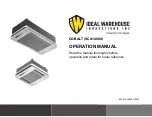
7
|
Piping installation
Installer reference guide
37
(A)RXF20~42C5V1B
R32 split series
4P519439-10J – 2021.06
7.3.2 Precautions when checking the refrigerant piping
INFORMATION
Also read the precautions and requirements in the following chapters:
▪
General safety precautions
▪
Preparation
NOTICE
Use a 2-stage vacuum pump with a non-return valve that can evacuate to a gauge
pressure of −100.7 kPa (−1.007 bar)(5 Torr absolute). Make sure the pump oil does
not flow oppositely into the system while the pump is not working.
NOTICE
Use this vacuum pump for R32 exclusively. Using the same pump for other
refrigerants may damage the pump and the unit.
NOTICE
▪
Connect the vacuum pump to the service port of the gas stop valve.
▪
Make sure that the gas stop valve and liquid stop valve are firmly closed before
performing the leak test or vacuum drying.
7.3.3 To check for leaks
NOTICE
Do NOT exceed the unit's maximum working pressure (see "PS High" on the unit
name plate).
NOTICE
ALWAYS use a recommended bubble test solution from your wholesaler.
NEVER use soap water:
▪
Soap water may cause cracking of components, such as flare nuts or stop valve
caps.
▪
Soap water may contain salt, which absorbs moisture that will freeze when the
piping gets cold.
▪
Soap water contains ammonia which may lead to corrosion of flared joints
(between the brass flare nut and the copper flare).
1
Charge the system with nitrogen gas up to a gauge pressure of at least
200 kPa (2 bar). It is recommended to pressurize to 3000 kPa (30 bar) in order
to detect small leaks.
2
Check for leaks by applying the bubble test solution to all connections.
3
Discharge all nitrogen gas.
7.3.4 To perform vacuum drying
Connect the vacuum pump and manifold as follows:















































